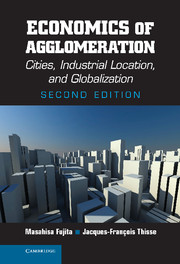Book contents
- Frontmatter
- Dedication
- Contents
- Acknowledgments
- Preface to the Second Edition
- 1 Agglomeration and Economic Theory
- Part I Fundamentals of Spatial Economics
- 2 The Breakdown of the Price Mechanism in a Spatial Economy
- 3 The von Thünen Model and Land Rent Formation
- 4 Increasing Returns and Transport Costs: The Fundamental Trade-off of a Spatial Economy
- 5 Cities and the Public Sector
- Part II The Structure of Metropolitan Areas
- Part III Factor Mobility and Industrial Location
- Part IV Urban Systems, Regional Growth, and the Multinationalization of Firms
- References
- Author Index
- Subject Index
5 - Cities and the Public Sector
Published online by Cambridge University Press: 05 August 2013
- Frontmatter
- Dedication
- Contents
- Acknowledgments
- Preface to the Second Edition
- 1 Agglomeration and Economic Theory
- Part I Fundamentals of Spatial Economics
- 2 The Breakdown of the Price Mechanism in a Spatial Economy
- 3 The von Thünen Model and Land Rent Formation
- 4 Increasing Returns and Transport Costs: The Fundamental Trade-off of a Spatial Economy
- 5 Cities and the Public Sector
- Part II The Structure of Metropolitan Areas
- Part III Factor Mobility and Industrial Location
- Part IV Urban Systems, Regional Growth, and the Multinationalization of Firms
- References
- Author Index
- Subject Index
Summary
INTRODUCTION
When seeking a reason for the existence of cities, the one that comes most naturally to mind is the supply of public services. In large measure, this is dictated by historical considerations. For example, in medieval Europe cities were signified in two ways: a physical boundary (the walled city) and a legal status (the democratized city). Clearly, walling a city exhibits increasing returns and corresponds to a local public good whose supply is governed by size effects: the length of a circular wall is 2πr, whereas the size of the corresponding area is πr2; the ratio of the circumference to the area falls as the radius r increases, and thus a larger number of individuals may be defended at a lower average cost. In addition to its defensive purpose, the wall was also the symbol of the city's political autonomy, and the corporate freedom of the towns brought emancipation to individuals. Historians agree that the specific legal status, which may itself be interpreted as a local public good, was a major criterion for identifying the city at least until the end of the Middle Ages (Bairoch 1988, chapter 1), if not later on. This clear-cut separation no longer exists. The legal status has been homogenized, except for minor exceptions, in most nations. Urban activities have gradually extended beyond the physical boundaries of the city to create suburbs, which are now very much part of the city considered as an economic agglomeration. As a result, the modern city is more dispersed and has fuzzy boundaries.
- Type
- Chapter
- Information
- Economics of AgglomerationCities, Industrial Location, and Globalization, pp. 149 - 184Publisher: Cambridge University PressPrint publication year: 2013



